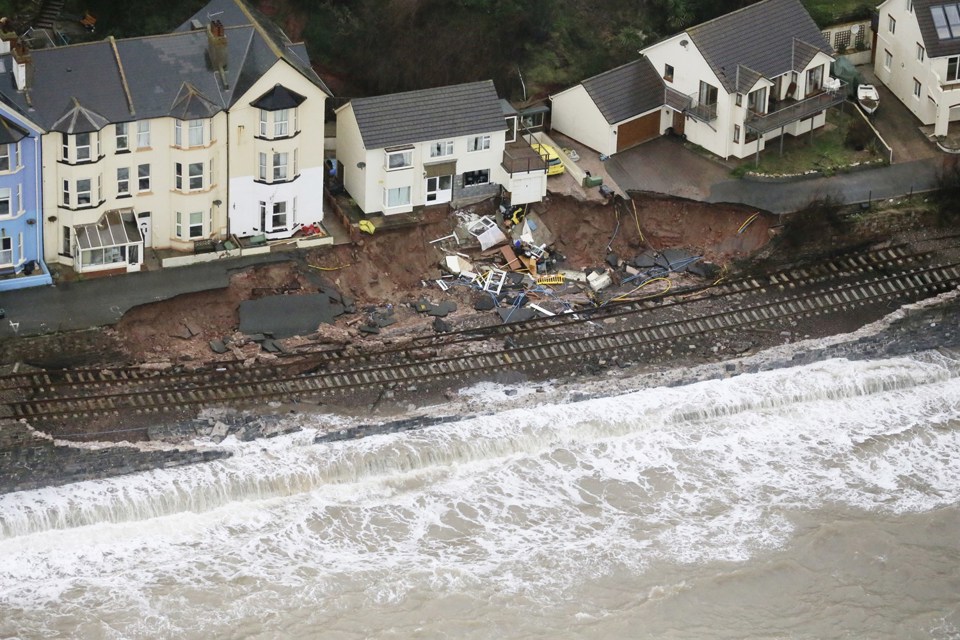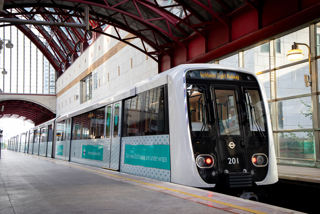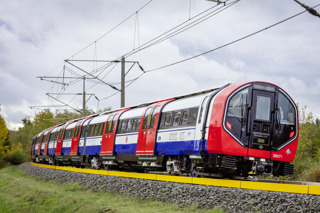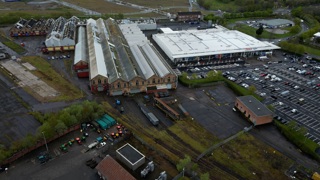The phone rang at around 2200 on February 4. “The Sea Wall has collapsed at Dawlish.”
I was sceptical. There is often talk in the press or among locals of problems on the Sea Wall, when in reality the English Channel is just a bit more choppy than usual, and a tiny bit of masonry has become dislodged.
But this time I was wrong. Spectacularly wrong!
The iconic Sea Wall had been punctured not far from the eastern end of Dawlish station. An 80-metre section of wall had been destroyed. Waves had battered the Brunel structure with such ferocity that it collapsed, leaving the double-track Exeter-Plymouth rail line suspended, like a hammock. Neighbouring houses were evacuated as engineers sought to hold the sea back. Trains, of course, were cancelled.
Network Rail has buoys in the English Channel that measure the force of Mother Nature. They had not recorded anything like the fury she unleashed on the Devon coast that night - for the first time ever, a ‘black’ warning was issued.
Since then, Network Rail has been working hard to get things back in order. But engineers always have one eye on the weather.
This is February and March, and the weather in the West Country at this time of year is far from the picture-postcard images you usually see. It’s cold, wet and windy. The storms are ferocious. One local MP said that the South West peninsula was becoming the focal point for the weather. He has a point.
RAIL 742 went to press on February 12, at which point NR was unable to state exactly when the railway would re-open. The next day, Secretary of State for Transport Patrick McLoughlin said it would be open on March 18 - six weeks after the wall collapsed, which seemed reasonable. Privately, sources talking to RAIL hinted that perhaps six weeks was a tad cautious.
And then Mother Nature intervened again.
On February 14, more storms caused further significant damage. Another ten to 20 metres of wall was destroyed. Shipping containers that had been welded together, filled with sand and stone, and placed in the gap as makeshift sea defences were also destroyed.
“The temporary Sea Wall at Dawlish has been swamped by massive seas during the night, which battered and damaged the ten-tonne shipping containers forming the temporary Sea Wall,” said NR the next day. “Further sections of the old Sea Wall are destroyed, as well as a lesser secondary breach closer to Dawlish Warren.
“Our engineers are working in very difficult conditions, with work taking place on a six-hours on, six-hours off basis, designed around the tidal patterns,” said NR.
On February 17, the weather calmed down, prompting NR to state: “More concrete foundations will be laid today. The additional damage to the Sea Wall caused by Friday night’s storm will have an impact on the timescales for restoring the track - we anticipate a new assessment on the timescales by the end of this week.”
NR announced on February 19 that trains would not be running before “mid-April’. This falls into the start of Control Period 5, the five-year period during which NR has £38 billion to spend - RAIL 714, 735, 742).
There have been calls for the money allocated to HS2 to be spent on diverting the railway across Dartmoor, but these calls are misinformed - the money comes from different pots. The money NR will spend on the wall comes from the maintenance and renewals funding, while the re-opening via Dartmoor would also come from a Control Period budget. HS2, by contrast, is funded separately.
Back to the wall. On February 16, NR had stated that an additional four shipping containers had been put into place to protect the new damage to the Sea Wall. Scaffolding has been built to give workers better access to start repairs. A cable bridge is being built so that NR staff can pass services and equipment over the rail bed, to allow cabling to be reconnected. Machinery has been arriving since February 6, two days after the initial storm.
In the meantime, 109 miles of railway in Cornwall and Devon remain cut off from the rest of the UK.
Passenger trains currently run to Exeter St Davids. Beyond the gap, local trains run to Teignmouth, while High Speed Trains run to Newton Abbot. Eight HSTs and 13 diesel multiple units are trapped in the peninsula for First Great Western, as well as four CrossCountry Voyagers.
All of which has led to calls for a diversion to be opened, with the most popular option appearing to be via Okehampton and Dartmoor. Rebuilding an 11-mile gap would be needed, but plans are already in place for a Bere Alston-Tavistock re-opening (this is progressing well), while the Okehampton-Exeter section is already open.
But what would that service be like?
RAIL Fares and Services expert Barry Doe says: “In the late 1950s the fastest Up service took 93 minutes from Plymouth to Exeter St Davids, calling at Tavistock and Okehampton only. This wasn’t the ‘Atlantic Coast Express’ - that always took longer, as it called at 11 intermediate stations to give the main through train of the day to Waterloo.
“Bear in mind these were steam timings. If 93 minutes seems slow, non-stop trains from Plymouth to Exeter St Davids via Newton Abbot took 79 minutes in those days!
“By the mid-60s timings on the LSWR route had improved, and one daily train took 86 minutes calling at Keyham, Tavistock and Okehampton.
“Now, consider that the planned re-opening to Tavistock from Plymouth is showing a projected 27-minute journey-time, which is five minutes faster than the above. So I would assume today Plymouth-Bere Alston-Tavistock-Okehampton-Exeter could easily be achieved in 75 minutes with those three stops. That’s only ten minutes slower than on the Great Western route with three stops.
“I’d say that the original closure was one of the most ludicrous of the 1960s. Re-opening would not only offer a main line alternative route to the west, it would also open up access to the rail network from north Cornwall, and provide a direct route from the affluent town of Tavistock to London - either through to Waterloo in four hours or under three hours into Paddington with a change at Exeter.”
However, the proposed route at Dartmoor has a big viaduct-shaped problem - Meldon Viaduct.
Mike Nendick, communications officer for Dartmoor National Park, says the viaduct is a Scheduled Ancient Monument, which would mean the involvement of English Heritage, the government advisor on the historic environment.
Even if a decision does not rest with the Dartmoor National Park’s planning department, it would still be a consultee on the planning application.
Nendick tells RAIL that re-opening that line would be “a monstrous undertaking before you even start construction”, because there are tunnels and stations along the route that are probably now in the hands of private individuals. Would they be subject to compulsory purchase?
“The LSWR route is also part of the National Cycle Network, which means Sustrans also need to be involved,” he adds. He thinks an alternative route to Newton Abbot would be shorter and more efficient.
Passengers, understandably, have been affected by the disruption, although First Great Western has been trying its best. The operator is running buses directly from Tiverton Parkway to Plymouth (which takes about an hour), while others are leaving Exeter St Davids to serve the affected towns.
“Flooding and storm damage is making things tough for rail passengers in various parts of the country,” says David Sidebottom, acting chief executive of Passenger Focus.
“It is good to see train companies accepting each other’s tickets, and lifting time restrictions on tickets where there is major disruption. Bus companies have also been helping out, and extra long-distance coaches have been laid on where rail services are affected.
“Passenger Focus is monitoring the quality of online information. And although there is a lot of good practice, the rail industry continues to struggle in this area. For instance, journey planners on February 10 were still showing some trains running via Dawlish - six days after the Sea Wall was destroyed.
“The immediate focus is rightly on restoring services as quickly as is safe to do so, but questions do need to be asked about passenger information accuracy and whether the level of investment in weather-proofing the railway needs to increase.”
Richard Burningham is manager of the Devon & Cornwall Rail Partnership. He tells RAIL: “What has happened at Dawlish is, of course, a big problem for those who want to get around by train, particularly in South Devon and Torbay. There will need to be a very big effort to get people back on the trains, and attract brand new users, once the line re-opens.
“Looking to the future, the key thing for me is that you have to provide a good rail link between Exeter and Newton Abbot/Torbay and Totnes, and provide the towns of Dawlish and Teignmouth with a rail service, too.
“As well as considering possible alternative rail routes, there also needs to be a look at what might be possible in the sea, to protect the coastline itself. Local MP Anne Marie Morris is calling for a breakwater.”
Responding to RAIL’s suggestion that the line via Dawlish is simply too important to be cut off, because of the communities it serves, Burningham says: “You are entirely right about the Sea Wall route providing a vital link to communities. Away from the area, this is often overlooked.
“Regarding alternatives, it strikes me that the Okehampton route could be re-opened quite quickly and at not huge expense if the will was there.
But, while restoring the railway to Okehampton and Tavistock, it would only act as a diversionary route when the Sea Wall route was unusable. There is some fear in South Devon that it would replace the existing railway, and this would not be the case at all.
“Re-opening the Okehampton route would ensure that Plymouth and Cornwall, barring some very freak weather, would always be connected by rail to the rest of the country.
“With the long-standing and well advanced plans to re-open the Bere Alston-Tavistock line, with Coleford Junction to Meldon Quarry still intact, and the Granite Way cycle way uniting ownership of 11 miles of the trackbed from Meldon to Lydford, there’s probably only a gap of around five miles where the trackbed is still in multiple ownership with some building on it.
“There are (as far as I am aware) just two missing bridges on the whole Meldon-Bere Alston section. Meldon Viaduct itself was refurbished in the mid 1990s, and prior to that had been used by lorries and a rail headshunt until (I believe) 1990.”
The importance of the railway was highlighted in a letter sent to Prime Minister David Cameron on February 7, signed by Tudor Evans (Plymouth City Council), John Hart (Devon County Council) and Steve Hindley (Chairman of Heart SW Local Enterprise Partnership).
The letter called for the work to repair the existing line to be undertaken “as a matter of urgency”, and for “an immediate release of the £31.3 million investment programme to support the ten-point programme submitted by Network Rail to help the rail system withstand more frequent flooding”.
It added: “We also need:
A fully funded investment scheme to ensure there is resilience across the South West rail network, and travel times are significantly enhanced
Co-ordinated capital investment from both Network Rail and the Environment Agency to work more closely together.
To connect Plymouth to the Strategic National Corridor network. It sends a clear message from Government to the private sector that they expect business growth, and is vital for business confidence. It costs the Government nothing, but will have a huge benefit for the city.”
The letter concluded: “The rail infrastructure in the South West has suffered from underinvestment for many years, and the entire region is now paying a very high price for this. We want to work with the Government to find practical and urgent solutions.
“Unless these fundamental issues are addressed now, the cost to the Government as a whole through a severely damaged regional economy will be massive.”
The cost to the region of the line being cut in two has varied by as much as £20m per day. If working only on weekdays, this means that by the time this edition of RAIL hits the shelves on March 5, the region will have lost £300m.
That is three times the predicted cost of re-opening the former Exeter-Plymouth via Tavistock line, according to a report written by the West Devon County Committee on November 19 2010 and delivered to the Executive Director of Environment, Economy and Culture.
The report stated: “The potential vulnerability of the railway between Exeter and Teignmouth, and more particularly the 4.2 miles between Dawlish and Teignmouth, became apparent soon after the opening of the railway, in 1846, when a storm destroyed part of the Sea Wall and led to temporary closure of the railway.
“Further cliff falls and sea damage were experienced in the 1850s and 1860s, and were followed by more serious breaches in 1916, and in the 1920s and 1930s. At that stage there was active consideration of an inland diversion around the rear of Dawlish. Further problems were experienced in 1986, and the 1990s.
“Furthermore, in the early years of the last decade, there were a number of occasions when adverse weather resulted in major disruption to train services. This was partly due to the susceptibility of the Voyager trains to spray, when the waves were so fierce that they broke over the roof of the train (where electrical equipment is sited).
“Particularly adverse weather conditions tend to occur on a 20-year cycle, caused by a combination of low pressure, high spring tides and southeasterly gales. Track circuits can get shorted and cables damaged, disrupting train detection and signalling systems. Breaches of the Sea Wall can also result in a washing away of ballast, resulting in its temporary closure.”
The report concluded: “Network Rail is confident that the railway sea defences around Dawlish will not fail in the foreseeable future. The costs of maintaining the sea walls and the estuary are approximately £500,000 a year. Network Rail considers that this regime of continuing maintenance, monitoring and route management will continue to be adequate until about 2025, after which an increased level of funding is likely to be required to maintain rail services along this route all day every day.”
The West Devon County Committee report discussed alternative routes, stating: “The impact of re-routing the Great Western Main Line on settlements within Devon needs to be considered.
“There would be disbenefits to Newton Abbot (removing its direct connectivity to London), and potentially Torbay, Totnes and Ivybridge - not to mention the other settlements such as Dawlish, Dawlish Warren, Starcross and Teignmouth, which would be cut off from the main line.
“There would still need to be a local service from Plymouth (serving Newton Abbot, Totnes, Ivybridge and Torbay).
“Re-routing the main rail line away from these settlements would be an unpopular proposal, and therefore serious consideration over the merits of its implementation would be required. Indeed, it is likely to be unacceptable.
“This position is the same as the UK government, as discussed in Parliament on November 10 2010 when the Transport Minister stated that this alignment will remain as the main line to Cornwall for the indefinite future. As such, it is important to note that the construction of an inland route, linking Exeter to Plymouth via Okehampton and Tavistock on the previous rail alignment, should not be viewed as an alternative to the existing Great Western Main Line route.
“Having said this, the reinstatement of this route would be welcome, and may indeed be considered in the very long term. However, there are some significant factors which affect the deliverability of this scheme.”
The report continued: “The section of track between Okehampton and Exeter also still remains, but has been reduced to single track and is operated by a private rail company. Furthermore, the alignment of the route between Okehampton and Tavistock has been utilised for other purposes. Areas of land with previous track alignments have been sold off, with the development of West Devon Borough Council offices, other property, and National Cycle Network (NCN) routes.
“In the 1890s there was a double express track. Reinstating this to modern standards is likely to be extremely expensive, and may require greater land take than the original alignment to meet modern railway standards. Other issues include the need to improve the track to overcome potential weight issues on the Meldon viaduct, which is a Scheduled Monument.
“As such, the costs are likely to be extremely prohibitive. There are further issues/constraints at Shillamill Viaduct and Tunnel.
“Further to the engineering requirements, there are also private land ownership issues, such as those in Tavistock where the West Devon Borough Council offices have been constructed.
“A House of Commons enquiry reported in February 2009 that the likely cost of reinstating this railway would be some £100m. Considering that the Government is committed to preserving the current alignment of the Great Western Main Line, it is extremely unlikely that such funding will come forward for this project in the near future.
“Having said this, and as stated above, the reinstatement of this route should not be prohibited by further development of the previous route for other uses. The NCN already acts to informally safeguard the route, and it is the county council’s intention that no further development (such as, of property) occurs on it.
“While the re-instatement of the full alignment between Exeter and Plymouth via Okehampton and Tavistock is unlikely to occur in the short term, it is also important to recognise ongoing developments that seek to introduce local services along some parts of this route.”
The report concluded: “The impact of re-routing the railway would have significant, and potentially unacceptable, implications for settlements located on it. As such, the Government has clarified that this will remain the alignment of the main line into Cornwall for the indefinite future.
“Having said this, the reinstatement of the former Southern Region rail route would still be welcome if it could be delivered. However, unfortunately, due to engineering and historic constraints, the cost of this is considered to be prohibitive. While this is the case for the foreseeable future, it is still intended to safeguard the route should circumstances change.
“In the meantime, local rail enhancements between Okehampton and Exeter and between Tavistock and Plymouth are being pursued at present. These will provide significant local benefit, and would not prevent the reinstatement of the longer route if this were eventually progressed.”
Transport Secretary Patrick McLoughlin did announce just after the wall was demolished at Dawlish that alternatives would be looked at. Business leaders have called for it, but so far there has been silence.


















Login to comment
Comments
No comments have been made yet.